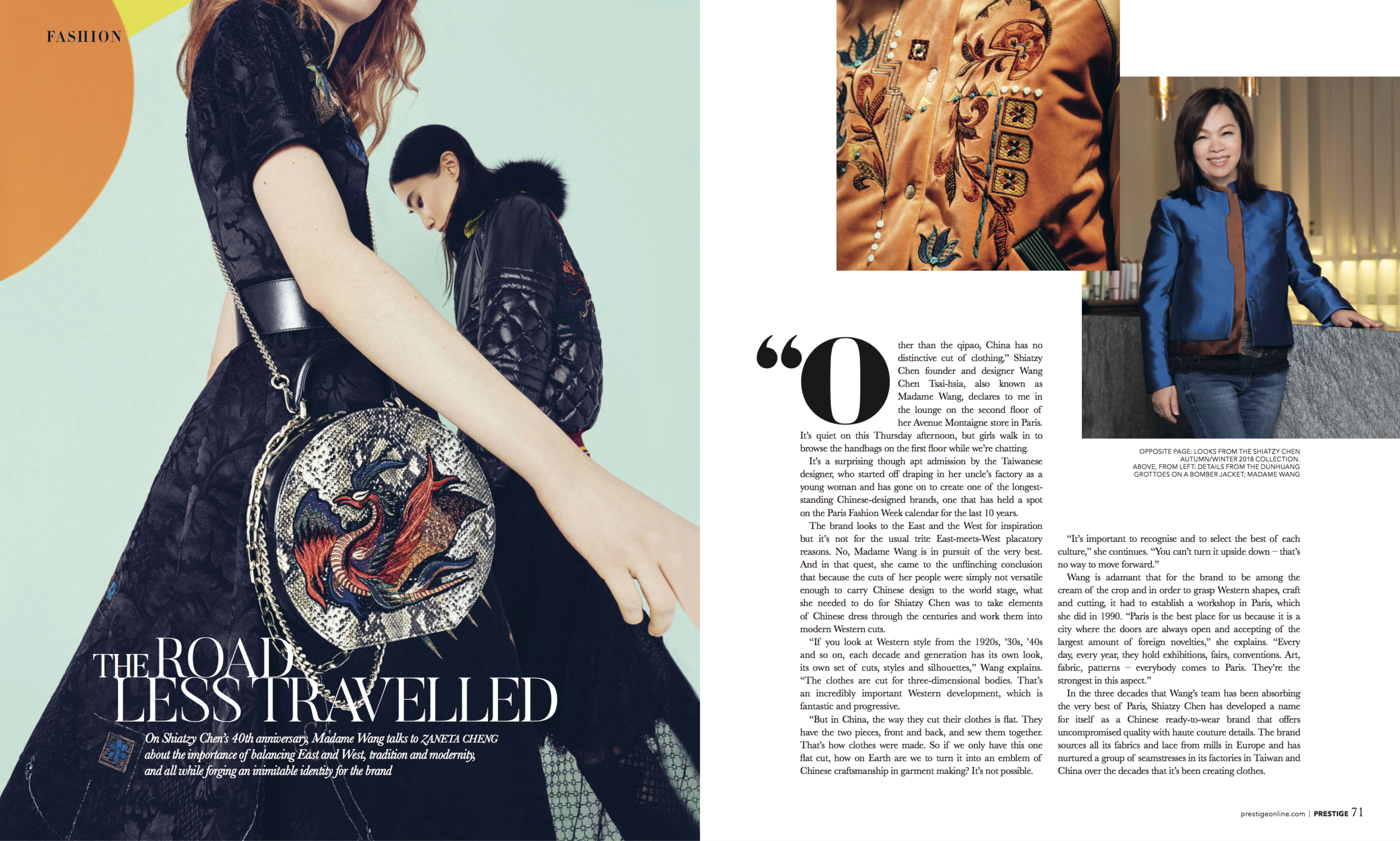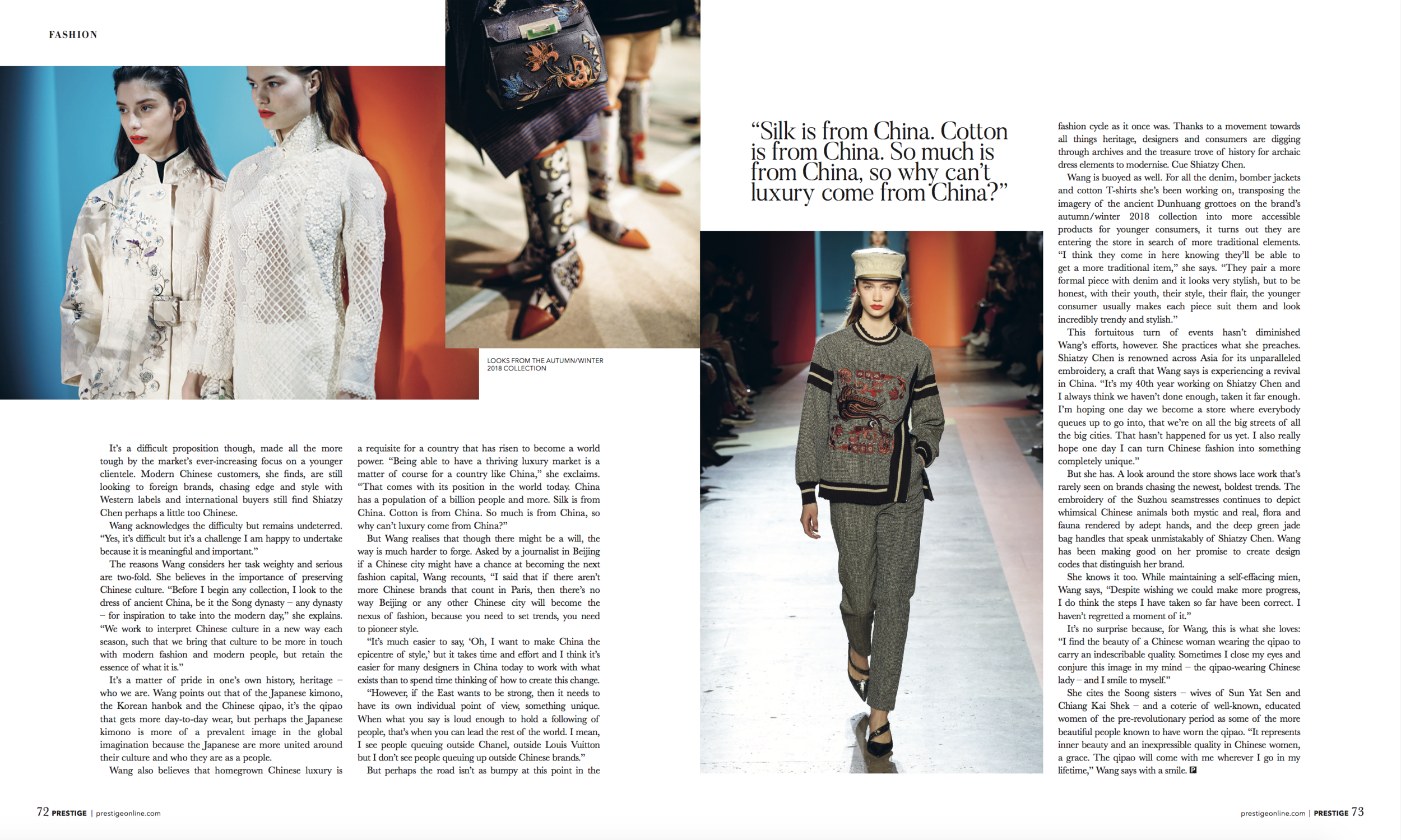Shiatzy Chen | Prestige Hong Kong (Dec 18)
On Shiatzy Chen’s 40th anniversary, Madame Wang talks to zaneta cheng about the importance of balancing East and West, tradition and modernity,
and all while forging an inimitable identity for the brand
Other than the qipao, China has no distinctive cut of clothing,” Shiatzy Chen founder and designer Wang Chen Tsai-hsia, also known as Madame Wang, declares to me in the lounge on the second floor of her Avenue Montaigne store in Paris. It’s quiet on this Thursday afternoon, but girls walk in to browse the handbags on the first floor while we’re chatting.
It’s a surprising though apt admission by the Taiwanese designer, who started off draping in her uncle’s factory as a young woman and has gone on to create one of the longest-standing Chinese-designed brands, one that has held a spot on the Paris Fashion Week calendar for the last 10 years.
The brand looks to the East and the West for inspiration but it’s not for the usual trite East-meets-West placatory reasons. No, Madame Wang is in pursuit of the very best. And in that quest, she came to the unflinching conclusion that because the cuts of her people were simply not versatile enough to carry Chinese design to the world stage, what she needed to do for Shiatzy Chen was to take elements of Chinese dress through the centuries and work them into modern Western cuts.
“If you look at Western style from the 1920s, ’30s, ’40s and so on, each decade and generation has its own look, its own set of cuts, styles and silhouettes,” Wang explains. “The clothes are cut for three-dimensional bodies. That’s an incredibly important Western development, which is fantastic and progressive.
“But in China, the way they cut their clothes is flat. They have the two pieces, front and back, and sew them together. That’s how clothes were made. So if we only have this one flat cut, how on Earth are we to turn it into an emblem of Chinese craftsmanship in garment making? It’s not possible.
“It’s important to recognise and to select the best of each culture,” she continues. “You can’t turn it upside down – that’s no way to move forward.”
Wang is adamant that for the brand to be among the cream of the crop and in order to grasp Western shapes, craft and cutting, it had to establish a workshop in Paris, which she did in 1990. “Paris is the best place for us because it is a city where the doors are always open and accepting of the largest amount of foreign novelties,” she explains. “Every day, every year, they hold exhibitions, fairs, conventions. Art, fabric, patterns – everybody comes to Paris. They’re the strongest in this aspect.”
In the three decades that Wang’s team has been absorbing the very best of Paris, Shiatzy Chen has developed a name for itself as a Chinese ready-to-wear brand that offers uncompromised quality with haute couture details. The brand sources all its fabrics and lace from mills in Europe and has nurtured a group of seamstresses in its factories in Taiwan and China over the decades that it’s been creating clothes.
It’s a difficult proposition though, made all the more tough by the market’s ever-increasing focus on a younger clientele. Modern Chinese customers, she finds, are still looking to foreign brands, chasing edge and style with Western labels and international buyers still find Shiatzy Chen perhaps a little too Chinese.
Wang acknowledges the difficulty but remains undeterred. “Yes, it’s difficult but it’s a challenge I am happy to undertake because it is meaningful and important.”
The reasons Wang considers her task weighty and serious are two-fold. She believes in the importance of preserving Chinese culture. “Before I begin any collection, I look to the dress of ancient China, be it the Song dynasty – any dynasty – for inspiration to take into the modern day,” she explains. “We work to interpret Chinese culture in a new way each season, such that we bring that culture to be more in touch with modern fashion and modern people, but retain the essence of what it is.”
It’s a matter of pride in one’s own history, heritage – who we are. Wang points out that of the Japanese kimono, the Korean hanbok and the Chinese qipao, it’s the qipao that gets more day-to-day wear, but perhaps the Japanese kimono is more of a prevalent image in the global imagination because the Japanese are more united around their culture and who they are as a people.
Wang also believes that homegrown Chinese luxury is a requisite for a country that has risen to become a world power. “Being able to have a thriving luxury market is a matter of course for a country like China,” she exclaims. “That comes with its position in the world today. China has a population of a billion people and more. Silk is from China. Cotton is from China. So much is from China, so why can’t luxury come from China?”
But Wang realises that though there might be a will, the way is much harder to forge. Asked by a journalist in Beijing if a Chinese city might have a chance at becoming the next fashion capital, Wang recounts, “I said that if there aren’t more Chinese brands that count in Paris, then there’s no way Beijing or any other Chinese city will become the nexus of fashion, because you need to set trends, you need to pioneer style.
“It’s much easier to say, ‘Oh, I want to make China the epicentre of style,’ but it takes time and effort and I think it’s easier for many designers in China today to work with what exists than to spend time thinking of how to create this change.
“However, if the East wants to be strong, then it needs to have its own individual point of view, something unique. When what you say is loud enough to hold a following of people, that’s when you can lead the rest of the world. I mean, I see people queuing outside Chanel, outside Louis Vuitton but I don’t see people queuing up outside Chinese brands.”
But perhaps the road isn’t as bumpy at this point in the fashion cycle as it once was. Thanks to a movement towards all things heritage, designers and consumers are digging through archives and the treasure trove of history for archaic dress elements to modernise. Cue Shiatzy Chen.
Wang is buoyed as well. For all the denim, bomber jackets and cotton T-shirts she’s been working on, transposing the imagery of the ancient Dunhuang grottoes on the brand’s autumn/winter 2018 collection into more accessible products for younger consumers, it turns out they are entering the store in search of more traditional elements. “I think they come in here knowing they’ll be able to get a more traditional item,” she says. “They pair a more formal piece with denim and it looks very stylish, but to be honest, with their youth, their style, their flair, the younger consumer usually makes each piece suit them and look incredibly trendy and stylish.”
This fortuitous turn of events hasn’t diminished Wang’s efforts, however. She practices what she preaches. Shiatzy Chen is renowned across Asia for its unparalleled embroidery, a craft that Wang says is experiencing a revival in China. “It’s my 40th year working on Shiatzy Chen and I always think we haven’t done enough, taken it far enough. I’m hoping one day we become a store where everybody queues up to go into, that we’re on all the big streets of all the big cities. That hasn’t happened for us yet. I also really hope one day I can turn Chinese fashion into something completely unique.”
But she has. A look around the store shows lace work that’s rarely seen on brands chasing the newest, boldest trends. The embroidery of the Suzhou seamstresses continues to depict whimsical Chinese animals both mystic and real, flora and fauna rendered by adept hands, and the deep green jade bag handles that speak unmistakably of Shiatzy Chen. Wang has been making good on her promise to create design
codes that distinguish her brand.
She knows it too. While maintaining a self-effacing mien, Wang says, “Despite wishing we could make more progress, I do think the steps I have taken so far have been correct. I haven’t regretted a moment of it.”
It’s no surprise because, for Wang, this is what she loves: “I find the beauty of a Chinese woman wearing the qipao to carry an indescribable quality. Sometimes I close my eyes and conjure this image in my mind – the qipao-wearing Chinese lady – and I smile to myself.”
She cites the Soong sisters – wives of Sun Yat Sen and Chiang Kai Shek – and a coterie of well-known, educated women of the pre-revolutionary period as some of the more beautiful people known to have worn the qipao. “It represents inner beauty and an inexpressible quality in Chinese women, a grace. The qipao will come with me wherever I go in my lifetime,” Wang says with a smile.

